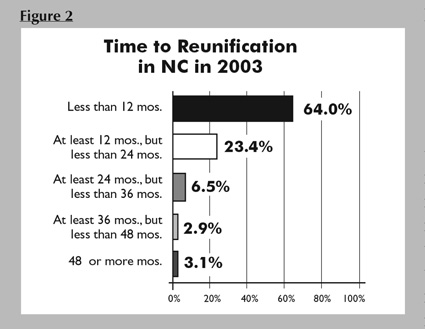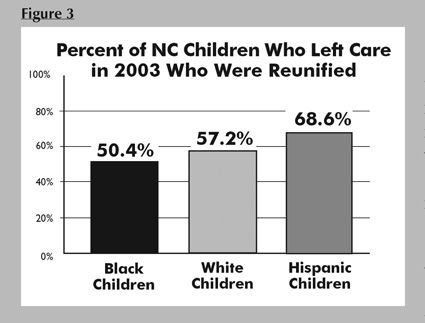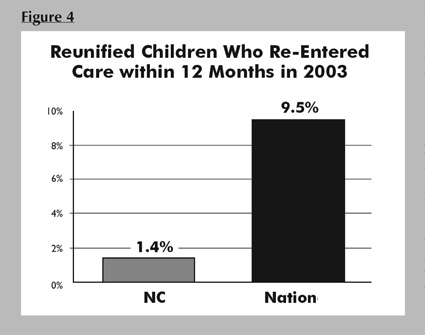Vol. 11, No. 1• November 2006
Reunification in North Carolina in 2003
To work effectively with children and their families, foster parents need to have realistic expectations. These expectations should be based at least in part on what we know about what happens to children and families involved with the child welfare system. In this spirit, we offer the following information about the reunification of children in foster care in North Carolina. This information is drawn from Child Welfare Outcomes 2003: Annual Report, which was released in fall 2006 by the US Dept. of Health and Human Services, Administration for Children and Families. Currently 2003 is the most recent year for which the federal government has complete statistics.
What Do We Know?
Reunification is the most likely outcome for children placed in foster care. In 2003, of the 5,067 children who left foster care in North Carolina, 2,784 (54.9%) were reunified with their families. Figure 1 illustrates the different destinations of the children who left foster care in 2003.
When reunification occurs, it usually happens in less than 12 months. Sixty-four percent of the NC children in foster care who were reunified with their families in 2003 spent less than 12 months in foster care. This percent falls short of the national median of 72%, but it represents an improvement in performance for North Carolina since 2000, when the percentage was only 59.2%. Figure 2 illustrates the amount of time the children who were reunified in 2003 had spent in foster care before returning home.
Reunification was not equally likely for children of all races in North Carolina in 2003. Although reunification was the most likely outcome for foster children of all races in 2003, as Figure 3 indicates, White (non-Hispanic) children were somewhat more likely to be reunified than Black (non-Hispanic) children, while Hispanic children (any race) were reunified more often than White children.
Relatively few North Carolina children re-enter foster care after they are reunified with their families. Although in 2003 North Carolina did not perform as well as most states when it came the percentage of children who were reunified within 12 months of their entry into foster care, our state had a very low percent of children re-entering foster care.
In 2003, only 1.4% of children entering foster care in North Carolina had been in foster care during the preceding 12 months. As Figure 4 illustrates, this is significantly lower than the national median for this performance measure.
This suggests North Carolina does a better job than many states of ensuring that sufficient changes have occurred in birth families before children return home and/or that sufficient post-reunification services are provided to birth families.
Copyright � 2006 Jordan Institute for Families




